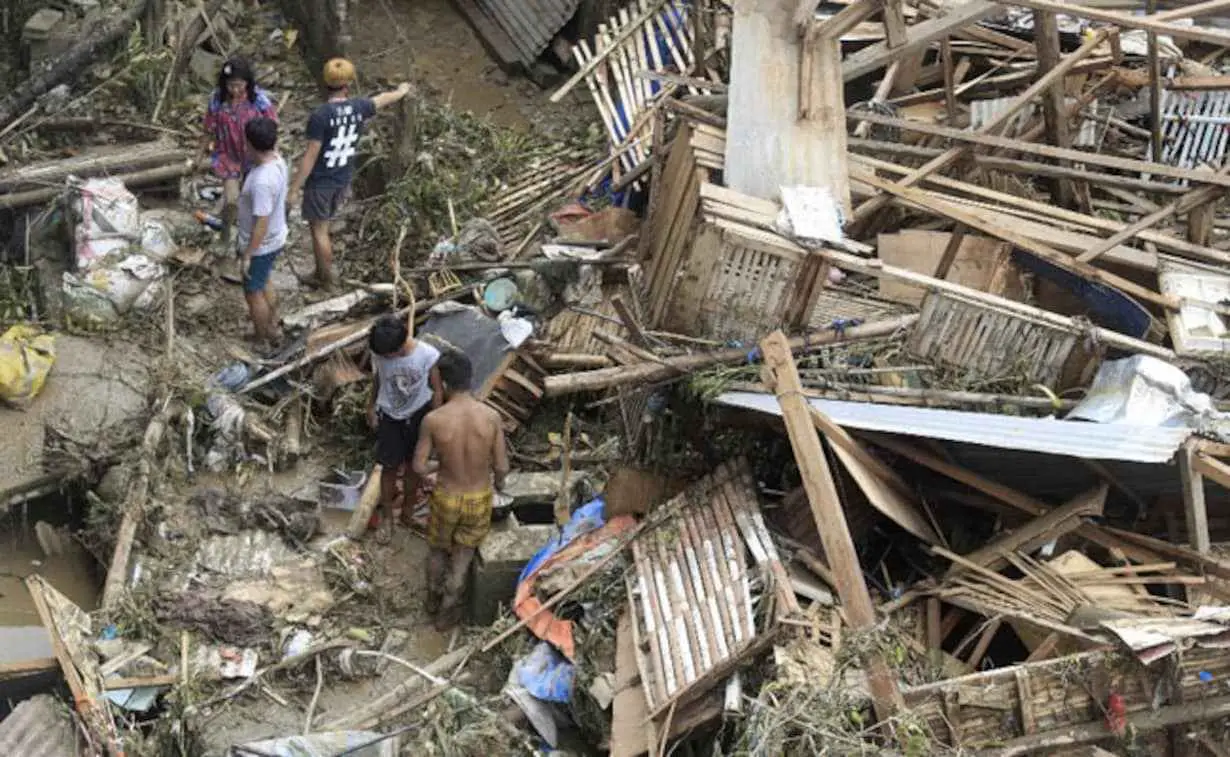Officials say at least 23 people have died as a result of the typhoon in the Philippines

As of Saturday, at least 23 people had died in the worst typhoon that has hit the Philippines this year. There have also been reports of "alarming" devastation on islands that bore the brunt of the storm, according to authorities.
A storm called Typhoon Rai ravaged the southern and central regions of the archipelago, forcing more than 300,000 people from their homes and beachfront resorts. The storm caused widespread communication and electricity outages as well as tearing off roofs and toppling concrete power poles in many areas.
In the Philippines, Typhoon Rai made landfall on the famous tourist island of Siargao on Thursday as a super typhoon with maximum sustained winds of 195 kilometers per hour (120 miles per hour) and a tropical storm warning.
In aerial photographs released by the military, the hamlet of General Luna, where many surfers and vacationers had come ahead of Christmas, appeared to have suffered significant devastation, with houses stripped of their roofs and debris covering the ground below.
The hurricane had "leveled to the ground" the neighboring island of Dinagat, according to Governor Arlene Bag-ao, who wrote on Facebook that houses, boats, and crops had been devastated.
Walls and roofs were ripped and blasted off by Odette, as Bag-ao described the typhoon in his own tongue. "Walls and roofs were torn and blown off like paper," he said.
"We're running out of food and water," says the author. "The power and telecommunications systems are down."
Rain sent down heavy rain, flooding communities, uprooting trees, and smashing wooden buildings as the storm barreled through the nation. Rai's wind speeds dropped to 150 kilometers per hour as the storm barreled across the country.
According to the state weather forecaster, it emerged over the South China Sea on Saturday and was heading towards Vietnam.
In fact, Alberto Bocanegra, the head of the International Federation of Red Cross and Red Crescent Societies (IFRC) in the Philippines, told AFP that this is one of the strongest storms to hit the country in the month of December in the previous decade.
"The information we are receiving, as well as the images that we are seeing, are really concerning."
It is estimated that at least 23 people died in all, according to government figures.
Mark Timbal, the spokesperson for the national disaster agency, said more than 18,000 military, police, coast guard, and fire personnel will join search and rescue efforts in the worst-affected areas, according to AFP.
When it comes to Siargao island and the northern point of Mindanao island, Timbal described "serious devastation," referring to locations that were subjected to the full force of Typhoon Mangkhut as it blasted into the nation.
There are around 100,000 people on Siargao, although the population grows as a result of the influx of visitors who come to enjoy the island's beaches and large waves.
'Everything was completely destroyed.'
The Philippine Coast Guard has posted photographs on social media showing massive devastation in the area of Surigao City, in the Mindanao province of Rizal.
Underwater rice fields may be seen in aerial footage from the air.
In the storm, at least three people were killed and scores more were injured, according to Surigao City Mayor Ernesto Matugas, who spoke to ABS-CBN.
The roadway was littered with shattered glass from busted windows, sheets of corrugated iron roofing, electric cables, and other debris.
According to the vice governor of Dinagat, at least six persons were murdered in the incident.
Residents of the island, which has a population of around 128,000 people, were "trying to restore their dwellings since even our evacuation centers were destroyed," said to Nilo Demery, a resident who spoke to ABS-CBN.
"They are unable to seek sanctuary in any other place... "Everything had been completely wrecked."
In the central province of Cebu, where the country's second busiest airport was destroyed and flights were stopped, Vice President Leni Robredo posted photographs of motorbikes crammed around a gas station and people queued up for drinking water on Twitter.
It was cautioned by Bocanegra that an interruption in electricity would have an impact on the water supply, causing worries about cleanliness and sickness.
Rai made landfall in the Philippines late in the typhoon season, when the majority of cyclones develop between July and October.
The scientific community has long cautioned that typhoons are growing more strong and intensifying more rapidly as the world warms as a result of human-caused climate change.
A total of 20 storms and typhoons strike the Philippines every year, wreaking havoc on already impoverished areas, including harvests, houses, and infrastructure. The country is regarded as one of the world's most vulnerable countries to the effects of climate change.
